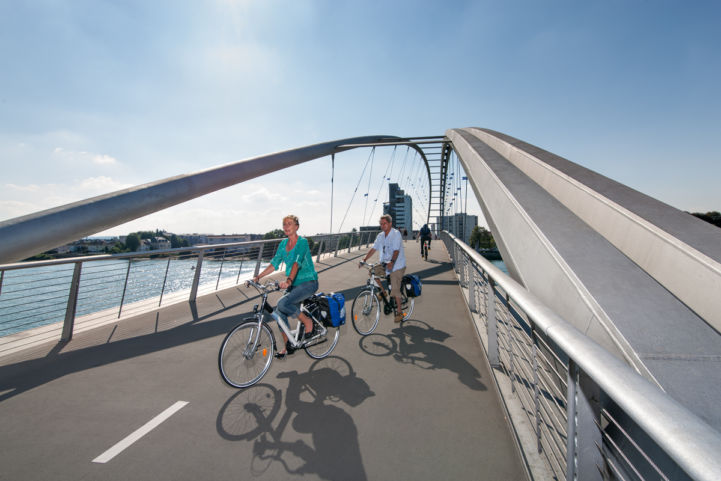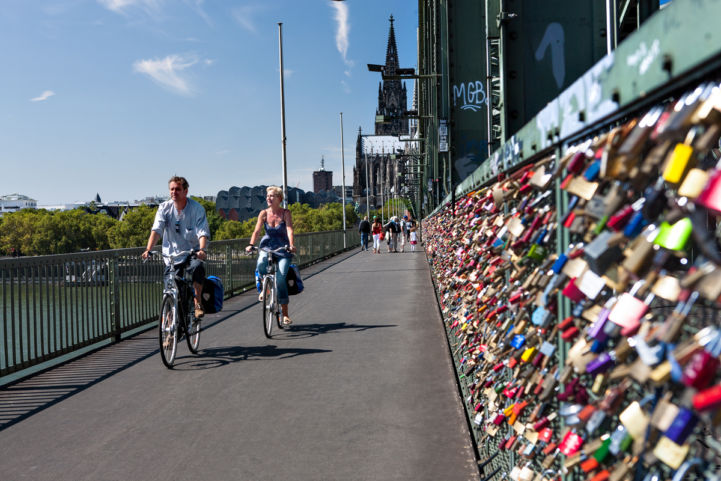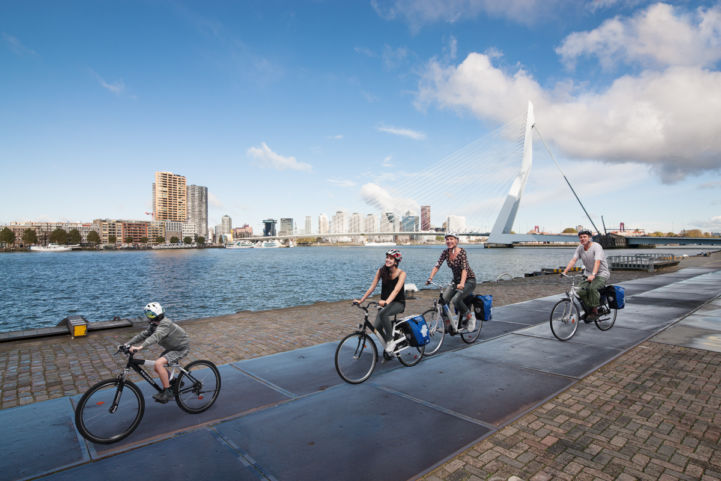Discover Europe – Overcome Boundaries
The EuroVelo 15 – Rhine Cycle Route is one of the most popular long-distance cycle routes in Europe. This is not just because of its unique landscapes that range from the Swiss Alps to the Dutch Sea, but also because of a tight collaboration of the bordering regions in Switzerland, France, Germany and the Netherlands. Even though the Rhine acts as a natural border in certain areas, it also has many linking elements. This becomes particularly apparent during a cycle tour along the Rhine Cycle Route and its fascinating Rhine crossings like bridges and ferries.
A very special border is the wooden bridge in Bad Säckingen between the German federal state Baden-Wuerttemberg and Switzerland. The bridge is more than 400 years old and around 205 meters long, which makes it the longest roofed wooden bridge in Europe. During the Middle Ages, it was destroyed repeatedly due to floodings. Therefore, the bridge was built on stony piers in 1570. The six piers and the superstructure that was built by Blasius Baldischwiler in 1810, still to this day shape the characteristic form of the bridge. A very popular photo opportunity is a white line in the middle of the bridge symbolizing the border between Germany and Switzerland.
The famous Three Countries Bridge is yet another symbol of a close bond between two countries. It connects the twinned towns of Weil am Rhein on the German and Huningue on the French banks of the Rhine. The bridge is the world’s longest self-supporting pedestrian and cyclists bridge with a support span of 230 meters and a total length of 248 meters. It has been awarded with several prizes, e.g. the German German Bridge Construction Prize 2008, the Arthur G. Hayden Medal as the highest international award, as well as the worldwide most prestigious engineering prize of the International Association for Bridge and Structural Engineering (IABSE), the Outstanding Structure Award.

Cyclists along the EuroVelo15 – Rhine Cycle Route who want to cross the river in the Rhine-Hessian city of Worms to the Hessian side of the Rhine should use the old Worms Rhine bridge. Since it was designed in the style of the Song of the Nibelungs, it is also called the Nibelungen Bridge. The bridge itself is not so old yet, but the neo-Romanesque 53 meter high Nibelungen tower was already built in 1900 according to the plans of master builder Karl Hofmann. The tower spans the roadway and thus offers a magnificent entrance to the city. On the opposite side there used to be an identical tower, which was destroyed shortly before the end of the war in 1945 and was not rebuilt.
There is no fixed Rhine crossing between the Rhineland-Palatinate state capital of Mainz and Koblenz, so ferries dominate the picture there. In the UNESCO World Heritage Upper Middle Rhine Valley between Bingen/Rüdesheim and Koblenz, the ferries have long since become an attraction in themselves. The profession of ferryman has existed since the Middle Ages and even today, locals and visitors alike enjoy using the ferries. So you can relax and enjoy the wind during a ferry crossing and a special view of the surroundings. Bicycles are expressly allowed on the ferries.
One of the most famous Rhine bridges is undoubtedly the Hohenzollern Bridge in Cologne - together with the Cologne Cathedral it shapes the cityscape. In recent years, the bridge has become a true place of pilgrimage for lovers. To express their eternal love and loyalty, they attach locks to the bridge lattice and throw the key into the Rhine. Since then, thousands of these love locks have adorned the bridge. On a bicycle tour along the Rhine cycle path, it is worth making a small stop to take a closer look at this phenomenon.

On the Dutch part of the EuroVelo 15 - Rhine Cycle Route, a short detour to Rotterdam is worthwhile, because there is not only a fascinating city waiting to be explored, but also one of the most unusual bridges in the Netherlands. The Erasmus Bridge reaches a height of 139 metres with a single pylon of light blue steel. 40 steel cables are stretched over a total length of 800 metres. Due to the unique shape of the bridge, it is also affectionately called "De Zwaan" ("The Swan"). The bridge connects the historic district of Delfshaven with the futuristic Kop van Zuid.

More information on the EuroVelo 15 – Rhine Cycle Route can be found at en.eurovelo.com/ev15.
Author(s): Maarten Van Hecke